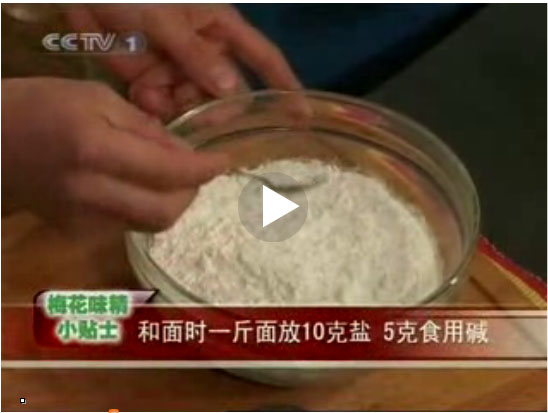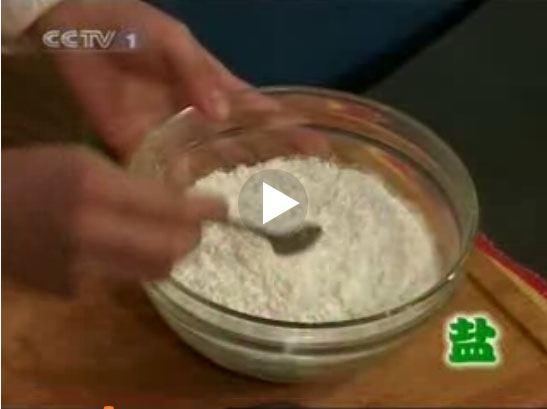I had the idea to check out google.cn today to see if I could find a lamian recipe. Well, I found video of a cooking show in which it looks like they explain… everything? I’m not sure, but there’s information about alkali in there. I can’t read it, however. I’ll have to get some translation done.
The website is http://www.zuiya.com/play-2047.html.
Here’s some screenshots of particular importance. I need to call my chinese friends to see who can read it 😀



Hi Luke,
Really enjoyed the noodle-making videos and am itching to try it myself.
I haven’t watched the Chinese video but I can give you a translation of the screen shots posted here.
The first one (with the bowl) is roughly – to make 500g of noodles you need 5g of salt and 10g of baking soda.
The second one (yellow background) is a recipe for beef noodles:
Ingredients – beef, wheat flour, garlic shoots, radish, coriander, salt, MSG, ground pepper and alkali/soda (not entirely sure what this is…)
Hope this helps.
Oh by the way the second screen shot just says ‘salt’.
Nice pro-am food porn. I’ve been itchin to try your noodle recipe but I’m commmited to extracting local honey tomorrow. Damn and blast!
Maybe breakfast noodles!
Sean
Actually the video says 10g of salt and 5g of baking soda, and it doesn’t talk about alkali at all.
The video seemed to have cut out some very important processes such as kneading. It did not talk about what type of flour should be used, so folks watching this would assume white flour and will probably fail IMO.
So here is a rough translation:
The video starts with an introduction of the dish (beef hand pulled noodle soup) The dish should be proportioned as 1 part clear (soup?), 2 part white (daikon – white radish), 3 part red (red pepper oil and beef) 4 part green (green onion) and 5 part yellow (noodle, as it contains baking soda)
The way to tell if a hand-pulled noodle place is authentic is that an authentic place would hand you a bow of clear soup as you walk in, so they made beef soup first – bring water and beef to a boil, get rid of the foam on top so it’s ‘clear’, then bring heat down and simmer for 40 mins.
For the noodle, they have 500g flour (unclear as of what type), 10g salt, 5g baking soda, (this ratio is said in the video to be very important, the ratio of salt to baking soda 2 to 1) and slowly mix in the water. then they go on talking about how the process of making hand-pulled noodle is a a good workout. After mixing the ingredients to form the dough, they let the dough sit for 15 minutes. Then they put oil on their hands to knead the dough (I noticed that the dough in the video doesn’t stick to the board at all, which suggest he didn’t put as much water in as other recipes suggests, however the dough is really soft too, as they only kneaded it for a few minutes and it was ready to be pulled, not a good workout at all… – this is probably ‘TV Magic’, meaning that they cut out the tedious kneading part, not even mentioning it at all actually) The pulling techniques are pretty much as you’ve (Luke) described in your blog, the host jokes about how his chubby belly is blocking the noodles.
So after they got the dough ready (before actually doing the final pulling), they put salt, MSG and Chinese pepper powder in the soup (this is after 40 minutes of simmering I am guessing, so… 40 mins of kneading cut out? which would actually make this a quite good workout)
So now they do the pulling. They pointed out two key factors:
1) As you pull the noodle apart, you should apply the same force with both arms as you pull, so the noodle is pulled evenly
2) As you grab the end of the noodle between your fingers (see Luke’s 2nd video) you should also apply even force
Before they do the final pulling, they press the dough flat so it’s like this:
__________
(__________)
Top-view
then they do the pulling, between each pull they touch the noodle on the lightly floured work area to prevent sticking.
When the noodle is about the right thickness, they are put into boiling water, but the chef said not to stir the noodle as it would break the noodle, wait until the noodle sinks to the bottom then it’s fine to stir. Boil for 5 minutes.
The final touch is adding in the other stuff, put the noodle in a bowl, pour in some beef soup, add in cilantro (coriander), garlic shoots, radish, boiled beef.
@Rusty:
Beautiful! Thank you so much!
I’ve been thinking about putting together a real webpage with all this noodle stuff on it. I just need to find time to do it. If I do, I’ll reference you and use your notes, if you don’t mind.
Good stuff! Thanks again 😀
I agree with what Rusty said – using only white flour will fail.
I tried about 4 cups of all-purpose flour with all the ingredients the video said, and it pretty much was a disaster. After about 20 minutes of kneeding the dough, it became so strong that it was too hard to even do ONE pull. Now I have 4 cups of flour resting in the fridge 🙁
The vid is a good all around tutorial for beginners who want to know how to do a pull, but the hard part imo is trying to get that elusive recipe.
Baking soda has molecule NaHCO2. In the video, I believe, they are using K2CO2 which is smiliar to baking soda.
K2CO2 is potassium carbonate aka liquid baking soda
It is not radish they put in (that tastes substantially different), but a related plant called daikon. Daikon isn’t as spicy and pungent, and is mild compared to regular radishes.